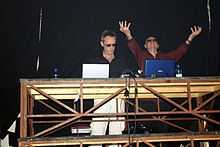Power electronics (music)
| Power electronics | |
|---|---|
| Stylistic origins | Industrial music, noise music |
| Cultural origins |
Early 1980s, United Kingdom Mid 1980s, Germany |
| Typical instruments | Synthesizer, drum machine, tape loops, drums, guitar, sampler, modified electronics, keyboard |
| Fusion genres | |
| Death industrial | |
| Other topics | |
| Post-industrial music | |
Power electronics was originally coined by William Bennett as part of the sleevenotes to the Whitehouse album Psychopathia Sexualis, and is related to the early Industrial Records scene but later became more identified with noise music.[1] It consists of screeching waves of feedback, analogue synthesizers making sub-bass pulses or high frequency squealing sounds, and screamed, distorted, often hateful and offensive lyrics. Deeply atonal, there are no conventional melodies or rhythms.[2] Artists include Philip Best, Sutcliffe Jügend, and Genocide Organ.
Tellus Audio Cassette Magazine produced a compilation compact cassette tape called Power Electronics in 1986 that was curated by Joseph Nechvatal.[3]

Death industrial
Death industrial is an industrial sub-genre typified by a dense atmosphere, low-end drones and screamed or distorted vocals. It can be differentiated from power electronics by a slower, more atmospheric sound reminiscent of dark or ritual ambient, and a less abrasive sound.[4] The term was first used to describe artists such as Brighter Death Now.[citation needed] Other artists include Anenzephalia, Atrax Morgue, Aelia Capitolina, Hieronymus Bosch, Stratvm Terror and Dead Man's Hill.
See also
- Experimental music
- Electroacoustic improvisation
- Sonology
References
- ↑ Whitehouse, Allmusic bio. Access date: March 15, 2009.
- ↑ Emily Benjamin, "Whitehouse Asceticists Susan Lawly". The Johns Hopkins News-Letter. February 14, 2006. Access date: March 15, 2009.
- ↑ Tellus #13 - Power Electronics (1986)
- ↑ "Death Industrial (aka Dark Noise)". Rateyourmusic.com. Retrieved October 20, 2011.
| |||||||||||